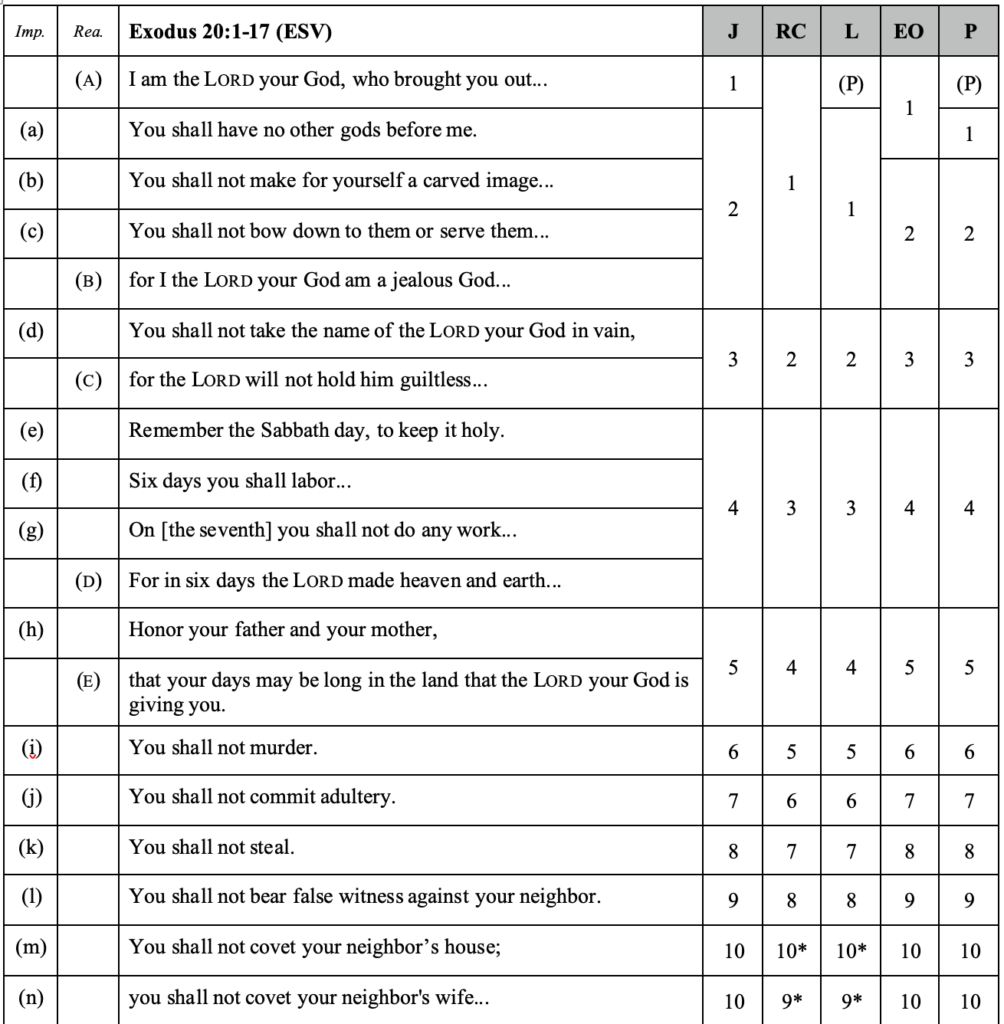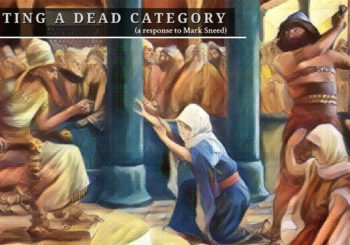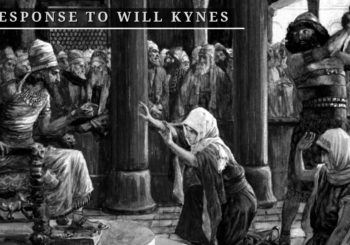Arranging the Decalogue: Punctuation Matters for Interpreting the Ten Commandments
It has been called the most expensive typo in history. In 1872, an extra comma was mistakenly inserted into a Congressional tariffs act. Lawmakers intended to include “fruit plants” on a list of duty-free imports. But the list included “fruit, plants” instead. As a result, the American market was accidentally opened to foreign grown oranges, grapes, and other fruits tariff-free. That single comma cost the U.S. government $2 million in expected revenue, equivalent to $43 million today. Punctuation matters.
Enjoying this article? Read more from The Biblical Mind.
Punctuation is important in biblical law, as well. But biblical Hebrew, in its original script, did not punctuate with marks like commas and periods. Phrases and lists were delineated through literary features such as prepositions, particles, conjunctions, repeated phrases, and other verbal markers. The resulting divisions are often clear. But sometimes they require close study to discern, as in the case of the decalogue, or the Ten Commandments.
Different Arrangements of the Decalogue
The proper numbering of the Ten Commandments has long been a matter of debate. Different reading traditions variously identify where certain commands begin and end, and how they are grouped. (See table below.)
For instance, the Roman Catholic catechism combines the prohibitions “you shall have no other gods before me” and “you shall not make graven images” as one, single command: the first commandment. But most Protestant catechisms divide those into separate commands: the first and second commandments. These differences lead to different interpretations. Under the Roman Catholic reading, images of false gods are prohibited but images of the true God are permitted. In most Protestant readings however, it is images (or icons) of the true God that are expressly off limits. Other interpretation issues also arise from how the commandments are divided. Punctuation matters.
I would like to note several literary features for a fresh look at the decalogue’s structure and how the resulting punctuation aids its interpretation. I will work primarily from the decalogue as recorded in Exodus 20:1–17, although reference will be made to the Deuteronomy 5:6–21 version as well.
Identifying the Tablets
We should begin with what is certain. Scripture states that there are “ten commandments (or words)” that were inscribed across “two tablets of stone” (Exod. 34:28; Deut. 4:13; 10:4). These statements lead us to expect ten commandments in two groups.
Some commentators suggest the two tablets were two identical copies, so that all ten commandments were repeated on each tablet. This conclusion is based on the ancient practice of drafting treaties between kings (called suzerainty treaties) in duplicate. One copy was kept by the suzerain (the sovereign king) and the other was given to the vassal (the subjugated king). Scholars aptly note certain resonances between ancient suzerainty treaties and the decalogue, such as their covenantal nature (Deut. 5:1–5). However, if the decalogue’s two tablets were treaty copies, it would seem that one copy would have remained on Sinai (with Yahweh as suzerain) and only one tablet would have gone to the people with Moses. In any case, none of the typical vocabulary of a duplicated text (see Deut. 17:18; Josh. 8:32; Jer. 32:11) appears in this passage. It is speculative to identify the two tablets as copies; it seems most natural to read the text—“[God wrote] the Ten Commandments . . . on two tablets” (Deut. 4:13)—as one copy of the commandments written across two tablets.
The decalogue’s division into two tables has traditionally been identified with two major themes evident in the commands. Rules about our relationship to God in the early commands are typically said to comprise the first table. Rules about relationships with other people are ascribed to the second table. Literary features to be noted below will confirm this division between the tables, but with an important refinement.
The Problem of Grouping Imperatives
Identifying the breaks between commandments to achieve the final number ten is famously tricky at points. There are at least fourteen imperatives in the text. (See the imperatives labeled (a) through (n) on the accompanying table.) Clearly some of these imperatives must be grouped together to arrive at ten commandments. Most readers attempt these decisions by joining imperatives with similar topics.
That is why Roman Catholic and Lutheran traditions view imperatives (a), (b), and (c) as forming one commandment. Those imperatives share a common theme of worship. Therefore, they are grouped in those traditions as a single command about worshiping God. But other traditions distinguish the theme of exclusivity (a) from imperatives about using images in worship (b) and (c), thus forming two commandments. Other imperative groupings are also commonly decided based on perceived thematic alignments. Attention to literary patterns, however, offers an objective basis for punctuating the commandments.
Reading the First Table
The first five commandments repeat the same, basic literary pattern. While some of them contain multiple imperatives, each command contains only one reason statement. (See the reason statements labeled (a) through (e) on the accompanying table.) These five reason or purpose statements punctuate the first five commandments, as follows:
I. Reason (a): “I am the Lord your God, who brought you out of the land of Egypt, out of the house of slavery.”
Imperative (a): “You shall have no other gods before me” (Exod. 20:2–3).
II. Imperatives (b), (c): “You shall not make for yourself a carved image. . . . You shall not bow down to them or serve them,”
Reason (b): “for I the Lord your God am a jealous God . . .” (vv. 4–6).
III. Imperative (d): “You shall not take the name of the Lord your God in vain,”
Reason (c): “for the Lord will not hold him guiltless who takes his name in vain” (v. 7).
IV. Imperatives (e), (f), (g), (h): “Remember the Sabbath day, to keep it holy. Six days you shall labor . . . but the seventh day is a Sabbath to the Lord your God. On it you shall not do any work . . .”
Reason (d): “For in six days the Lord made heaven and earth . . .” (vv. 8–11).
V. Imperative (i): “Honor your father and your mother,”
Reason (e): “that your days may be long in the land that the Lord your God is giving you” (v. 12).
The first command has its reason statement at its beginning. The rest end with reasons. The unique order for the first commandment is likely for theological as well as stylistic reasons. It is God’s redemption that initiates his relationship with his people, therefore that foundational reason for the first commandment—and for the whole decalogue that follows—is the opening declaration. And the first table ends with a promise, since the fifth commandment has a promise (Eph. 6:2) as its reason statement. Thus the first table is framed by grace and promise.
These groupings to form the first five are further supported by a second literary pattern. The phrase “the Lord your God” (literally, “Yahweh your God”), also appears five times in total. The divine name Yahweh (translated “Lord”) appears eight times. But the phrase of divine belonging, “Yahweh your God,” appears only five times: once in each of the first five commandments. (Four additional uses of the phrase are found in the Deuteronomy decalogue due to expansions in the fourth and fifth commandments.) This feature identifies the first table as listing commands about our relationship with the Lord, upholding Yahweh as “our God.”
Together, those two features—the five purpose statements and the five invocations of “Yahweh your God”—doubly confirm the punctuation of the first five commandments. They confirm the traditional Eastern Orthodox reading as punctuating the decalogue correctly. Most Protestant readings share the same divisions, except that the opening declaration “I am Lord your God” is here identified as part of the first commandment rather than just a preface. The first commandment as a whole (not just the opening redemption statement) introduces the decalogue.
Reading the Fifth Commandment in the Decalogue
Perhaps the most significant result of this division is the identification of the fifth commandment (“honor father and mother”) with the first table of the law. When punctuation decisions are made subjectively rather than by objective literary patterns, readers group the fifth commandment with laws about relationships with other people on the second table. But these punctation indicators lead us to read the fifth as part of the first table.
In fact, the fifth commandment serves as a seam or hinge between the two tables. It both completes the series of commands defining our relationship to God and also points ahead to the second table’s shift in focus to commands about human relations. It could fit thematically on either table, but its most important function serves the first table. Note the fifth commandment’s stated purpose. Its most important purpose is to maintain the people’s place “in the land that the Lord your God is giving you.” This too is a command primarily about preserving the people’s relationship to the Lord.
Throughout the Torah, parental instruction is the primary means whereby a new generation grows up knowing the stories and ways of God. Honoring parental instruction from youth is essential for continuing the faith across generations. As parents train their children and children honor that teaching, the community’s place in God’s presence remains secure (Deut. 6:1–25). In other words, the fifth commandment is not simply about obeying parents. The fifth command is about the parental duty to teach God’s ways to the next generation, and each generation’s fidelity to that received heritage (Psa. 78:5–8; Eph. 6:1–4).
The traditional interpretation of the fifth commandment as promoting obedience to human authority is certainly included within its purview. But punctuating the tablets based on their literary patterns brings out an emphasis in the fifth commandment which is often missed. The fifth commandment is especially concerned with fidelity to a godly heritage conveyed across generations.
Reading the First and Second Commandments
Before turning to the second table, let’s consider one more pattern in the first table. The opening two commands are bound together with special importance. The first and second commandments convey God’s voice in the first person. “I am the Lord your God. . . . You shall have no other gods before me.” And “you shall not make for yourself a carved image . . . for I the Lord your God am a jealous God, visiting the iniquity of the fathers on . . . those who hate me, but showing steadfast love to thousands of those who love me and keep my commandments.” The rest of the commandments refer to God in the third person (“he”/“him”).
We earlier affirmed the Eastern Orthodox and the typical Protestant punctuation of the first two commandments. But the unique use of first-person pronouns across those commandments affirms that the Roman Catholic and Lutheran reading is rightly sensitive to a special link between those commandments (compare also the Jewish division). Although the opening three imperatives (a), (b), and (c) are punctuated as two commandments, those two commandments share a common theme of worship and are are specially bound by this pronoun usage.
The intimacy conveyed by their use of first-person pronouns shows that the Lord is especially zealous about worship as communion with his people. In worship, he remains our exclusive savior (commandment one) and we come to know him as he really is (commandment two; cf., Deut. 4:12–18). All five commandments on the first table are vital for the people’s right relationship to “Yahweh their God.” But the opening two commands about worship form the heart of that relationship.
Reading the Second Table
A sudden change in literary form marks the second table. There are no longer purpose statements nor is the divine name invoked in the last five. The remaining commands are succinct with a single imperative for each one. Only the final commandment has a double imperative. The imperatives (m) and (n) repeat the same exhortation twice, “you shall not covet.”
The Deuteronomy decalogue further punctuates the second table using conjunctions. In Deuteronomy 5:17–21, the sixth commandment lacks a conjunction (indicating its role at the beginning of a new series) while commandments seven through ten each begin with a waw conjunction (translated “and”). This indicates the grouping of these commands together as the second table, beginning with the sixth (not with the fifth as often supposed):
VI. “You shall not murder” (Deut. 5:17).
VII. “And you shall not commit adultery” (v. 18).
VIII. “And you shall not steal” (v. 19).
IX. “And you shall not bear false witness against your neighbor” (v. 20).
X. “And you shall not covet . . .” (v. 21).
Thematically, these commands form the second table of the law with focused concern for the integrity of human relationships.
Punctuating the Tenth Commandment
The tenth is the only commandment on the second table with two imperative statements, (m) and (n). In the Exodus version, these two imperatives repeat the identical verb: “you shall not covet (chamad).” In the Deuteronomy version, the two imperatives use different verbs: “you shall not covet (chamad)” and “you shall not desire (‘awah).” In Roman Catholic and Lutheran arrangements, these imperatives are divided into separate commandments (the ninth and tenth). But there is another literary pattern that indicates they are properly read as a single commandment. Note the structure of this commandment in both its Exodus and Deuteronomy presentations:

Both versions begin with an imperative (m) that has a single prohibition. Both follow with a second imperative (n), this time introducing a list of prohibitions. This structure creates a Hebrew technique called a “parallelism.” The first imperative introduces the main prohibition which the second imperative further develops, in this instance with a list. This is a kind of parallelism which holds together these paired imperatives as a single commandment.
To illustrate, imagine a teacher tells a class of young children, “Paint a colorful rainbow! Paint a red, orange, yellow, green, and blue rainbow!” The second statement repeats in a list what was contained as a single statement in the first. That is what we call a “synonymous parallelism” when found in Hebrew texts. The Exodus version of the tenth commandment is a synonymous parallelism, where the “neighbor’s house” (or, “household”) named in the first imperative is defined by the list in its parallel.
The Exodus decalogue was announced at Mount Sinai, where the people were camped in tents (not houses). In that context, the imperative “you shall not covet your neighbor’s house” uses the term “house” to refer to the entire household. The second imperative then lists representative elements of a household, beginning with a neighbor’s wife. This is a synonymous parallel.
The Deuteronomy decalogue presents a slightly different kind of parallelism, however. Deuteronomy’s restatement of the decalogue occurred on the border of the Promised Land, as the people anticipated settling in Canaanite cities and towns—and dwelling in physical houses. In this setting, the term “house” is used for a physical structure. Note how “house” is paired with “field” in Deuteronomy. This changed use of the term “house” required its relocation into the secondary list. In this version, the man’s “wife” now represents the household in the first imperative, and the physical house is part of the household list under the second imperative.
To illustrate the Deuteronomy version, think of a teacher who tells the class, “Paint your family! Draw your house, your friends, your pets, and your toys!” In this example, the secondary list expands upon the first instruction rather than repeating it. In Hebrew studies, we call this a “synthetic parallelism” in contrast to the synonymous parallelism illustrated before.
The Exodus version of the tenth commandment uses synonymous parallels. The “house(hold)” named in the first imperative is what is enumerated in the second imperative list. The synonymous nature of the Exodus parallel is supported by the repetition of the exact same verb “covet” (chamad) for both imperatives. But the Deuteronomy version employs synthetic parallelism. In the main imperative, the man’s “wife,” his partner in establishing a household, is named. The second imperative then expands upon elements of the household the man and his wife establish together, beginning with their house (a building) and field. The change of parallelism from synonymity to synthetic is supported by the use of a different pair of verbs in the Deuteronomy version. In Deuteronomy, “You shall not covet (chamad)” is followed by “you shall not desire (‘awah).”
All these observations indicate the care with which the wording of the tenth commandment was modified from the Exodus prototype to address the new, settled condition expected for Deuteronomy’s audience. The key factor was to recast the term “house” as a building in Deuteronomy in contrast to its use for the household in Exodus.
By noting these details, we can confirm that the two imperatives (m) and (n) at the end of the decalogue are not to be punctuated as separate commandments. Rather, they capture a form of Hebrew parallelism that indicates their bond together as a single commandment.
Reading the Tenth Commandment
The elaborate structure of the tenth commandment suggests its importance at the close of the second table. As the first table began with first person pronouns to elevate the commands on worship, the second table ends with a climactic parallelism and a finale-like list that conveys special emphasis. The tenth commandment is a resounding exclamation point at the end of the second table.
In a sense, this final commandment does not introduce anything new. The eighth commandment already prohibited stealing a neighbor’s ox or his possessions. The seventh commandment already prohibited adultery with a neighbor’s wife. Violence against the persons of a neighbor’s household and violation of a neighbor’s trust have already been prohibited in the sixth and ninth commandments. The tenth commandment rehearses the topics already marked by the previous commands of the second table. This final commandment does not add any new prohibitions; rather, it points to the selfishness that motivates those behaviors as itself damnable.
Jesus taught that the sum of the Law is to love (Matt. 22:34–40). The final commandment captures the functional opposite of love as the fundamental sin against one’s neighbor. Biblical love is the promotion of others’ interests at one’s own expense (1 Cor. 13:1–13; Php. 2:1–4); but covetousness is the pursuit of one’s own interests at others’ expense. The tenth commandment does not identify another bad behavior, rather it points to a person’s lack of love for a neighbor as the root of such behavior.
It is remarkable to end the decalogue with a commandment about an attitude. None of the other known law collections from the ancient Near East contain commands against attitudes. Certainly, ancient lawmakers understood that evil attitudes motivate bad deeds. But laws in the ancient world always address behaviors, not attitudes.
The closest parallel to the tenth commandment in other ancient law collections would be the following law (§25) from the Babylonian king Hammurabi: “If a fire breaks out in a man’s house, and a man who came to help put it out covets . . . and takes household furnishings belonging to the householder, that man shall be cast into that very fire” (trans., Martha Roth). Other ancient legislators recognized that evil thoughts motivate bad deeds. But the tenth commandment is remarkable as a law that directly condemns an attitude.
Thus, adulterous lust in the heart, even if never acted upon, breaks the commandment (Matt. 5:27–28). And murderous words, even if never exercised, violate the law (Matt. 5:21–22). The Apostle Paul, in his letter to the Romans, pointed to the tenth commandment as the one that particularly convicted him. “I would not have known what it is to covet, if the law had not said, ‘You shall not covet’. But sin, seizing an opportunity through the commandment, produced in me all kinds of covetousness . . .” (Rom. 7:7–8).
The tenth commandment takes all the prohibited behaviors whereby we offend others and explicitly calls out the selfishness behind them as, itself, damnable. It is the tenth commandment that teaches us that righteousness in life requires a righteous heart, and that the sum of the law is indeed to love.
Punctuating the Ten Commandments
For centuries, different Jewish and Christian traditions have punctuated the decalogue differently. Most of the divisions are obvious. The major traditions agree on the break points between most of commands. But differences persist in how commandments are distinguished at the beginning and the ending of the decalogue, where multiple imperatives make discerning the right groupings a challenge. I argue that the solution can be found by focusing on the text’s literary features, rather than trying to align statutory imperatives thematically.
By adopting a literary approach to the decalogue, I conclude that the Eastern Orthodox tradition offers the best enumeration of the commandments. However, none of the major traditions place the fifth commandment (“honor parents”) on the first table as here proposed. And while the Roman Catholic and Lutheran traditions are incorrect to combine the first three imperatives into a single command, they nonetheless rightly discern an integral connection between those two commandments on worship. The first-person pronouns in those commandments identify worship as the heart of the first table. And the unique role of the final commandment, indicated by its form (parallelism) and its content (addressing the heart), underscores the importance of love for one’s neighbor as the summary concern of the second table.
There is much more to be said about the Ten Commandments; this article has focused on matters of punctuation. But punctuating the decalogue not only helps us to recognize its structure. Punctuating the decalogue helps us to recognize its heart. Structural features help us to see that sum of the law truly is to love God and to love one’s neighbor.


Subscribe now to receive periodic updates from the CHT.





